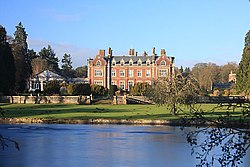Lynford Hall
| Lynford Hall Hotel | |
| Norfolk | |
|---|---|
 Lynford Hall | |
| Location | |
| Grid reference: | TL81929404 |
| Location: | 52°30’50"N, 0°40’46"E |
| Village: | Mundford |
| History | |
| Address: | Lynford Hall Hotel Mundford Nr Thetford Norfolk IP26 5HW |
| Built 1874 | |
| Country house | |
| Neo-Jacobean | |
| Information | |
| Condition: | Converted to hotel |
| Website: | lynfordhallhotel.co.uk |
Lynford Hall is a neo-Jacobean country house at Mundford, north-west of Thetford in Norfolk. It is now a hotel.
Lynford Hall is found a little east of the A1065 which links Fakenham to Mildenhall, 37 miles south-west of the city of Norwich.
History
The first hall at Lynford was built in about 1500.[1] In about 1717 James Nelthorpe acquired the Lynford estate from Sir Charles Turner. He built a new house with pleasant gardens, plantations and water features a little distance from the old hall which became the farm-house.[2]
The estate remained in the Nelthorpe family until 1805 when it was acquired by George Eyres. After several other owners, it was purchased by Sir Richard Sutton in 1827. Sutton commissioned the architect Charles Robert Cockerell to alter and remodel the house and expanded the grounds and park. The estate was sold in 1856 to Stephens Lyne-Stephens, who demolished the house in 1863.[1]
Stephens was said at the time to be the richest commoner in the land and commissioned present house which was built between 1857 and 1862 by William Burn He was married to the French ballerina Yolande (Pauline) Duvernay for whom he had a Roman Catholic chapel built out of native flintstone. Stephens died before the estate house was completed, but Yolande retained the house and estate until her death in 1894.[3]
Under later owners, regular guests included Joe Kennedy, then the United States ambassador to the United Kingdom. He was often accompanied on his visits by his sons Joe Jr., John (who later became President) and Robert. Ernest Hemingway is said to have propped up Lynford's Royal Wellingtonia bar with Sir James Calder, in the 1930s. Joe Kennedy Snr. was the United States ambassador to Great Britain at the time.[4][5][6]
Hemingway described shooting on the estate as "like sucking the core out of a fig."[7]
Lynford was gutted by fire in the 1920s destroying the east wing of the building, (which has yet to be replaced). There are still many signs of the fire, the most obvious being that the third floor window surrounds now stand proud of the roof.
The government used the Hall as a hospital during the Second World War. Some carved names can still be found in trees on the grounds from this period. The estate house was also used by American forces during the War, and they installed a hot water central heating system for the main building.
The Forestry Commission bought the Hall and used it as a training school until the 1960s. By this time the house was poorly maintained and overgrown. In 1960, the house was leased to Peter Widdowson, who, with a partner from London, made some repairs to the house and grounds, operating it as an apartment building, hotel and public house. Later, the Forestry Commission sold the house to John Haire, Baron of Whiteabbey but kept the estate lands which now make up a large part of Thetford Forest.
The house was bought by Gerald F. Rand in 1970 who converted the house into a private home and motel, with function facilities. He also developed a mobile home park to the east of the house with some 40 plots. After 25 years Rand sold the property, complete with businesses, in the mid-1990s. Lynford has been a hotel and conference centre for some years.
On television
During Rand's ownership, the BBC filmed several programmes there, including Dad's Army, You Rang, M'Lord? and 'Allo 'Allo! (for which the courtyard was transformed in the town square of Nouvion).[8]
Outside links
References
- ↑ 1.0 1.1 National Heritage List 1000224: Linford Hall
- ↑ Francis Blomefield. "'Hundred of Grimeshou: Linford', in An Essay Towards A Topographical History of the County of Norfolk: Volume 2 (London, 1805), pp. 263-266.". British History Online. https://www.british-history.ac.uk/topographical-hist-norfolk/vol2/pp263-266. Retrieved 15 April 2019.
- ↑ Roberts pp. 271-281
- ↑ About Mundford – Mundford Parish Council
- ↑ The Other Sandringham – Britain Express
- ↑ Bonhams auction catalogue
- ↑ From the now defunct Ipswich Courier, 13 May 1932, available on microfiche in the Ipswich Public Record Office
- ↑ ''Allo 'Allo plaque to remember WW2-based sitcom': BBC News 11 June 2019
- Jenefer Roberts Glass:The Strange History of the Lyne Stephens Fortune Templeton Press 2003